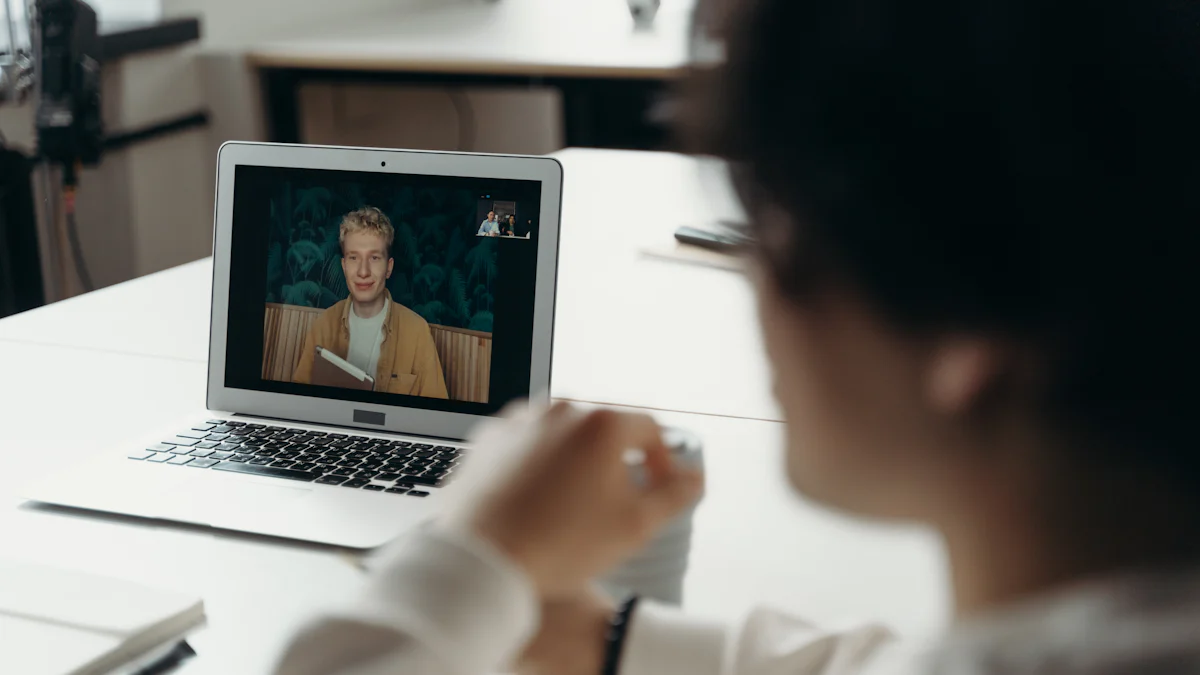Tips for Sounding Professional on Zoom Calls

Sounding professional on Zoom calls is more important than ever. In today's digital age, your voice can make or break a professional relationship. Clear communication not only enhances understanding but also boosts productivity. Did you know that companies with effective communication strategies outperform their competitors by 3.5 times? Moreover, poor communication can cost a company over 18% of their total salaries annually. By learning how to sound professional on Zoom calls, you can ensure your message is heard and valued, fostering stronger connections and success in your professional endeavors.
Key Takeaways
- Invest in a quality microphone to enhance your audio clarity during Zoom calls.
- Create a quiet environment by choosing the right space and minimizing background noise.
- Test your audio settings before meetings to ensure clear communication.
- Speak clearly and confidently, using enunciation and controlled pacing.
- Avoid slang and filler words to maintain a professional tone.
- Engage in active listening to foster better communication and understanding.
- Implement these strategies to boost productivity and strengthen professional relationships.
Enhancing Audio Quality

To sound professional on Zoom calls, you need to focus on enhancing your audio quality. Let's dive into some practical tips.
Choosing the Right Microphone
A good microphone can make a world of difference in how you sound during virtual meetings. Here are some options to consider:
Types of microphones suitable for Zoom calls
- USB Microphones: These are easy to use and provide excellent sound quality. Simply plug them into your computer, and you're ready to go.
- Conference Room Microphones: These specialized microphones capture clear, crisp audio. They often come with features like noise cancellation and omnidirectional pickup patterns, making them ideal for group settings.
- Lapel Microphones: If you prefer a hands-free option, lapel mics clip onto your clothing and offer great sound quality without being intrusive.
Tips for setting up your microphone
- Positioning: Place the microphone at a comfortable distance from your mouth. Too close, and it might pick up breathing sounds; too far, and your voice may sound distant.
- Testing: Always test your microphone before the meeting. This ensures that your audio is clear and free from any technical glitches.
- Environment: Use a quiet room to minimize background noise. Consider using noise-canceling technology if your environment is particularly noisy.
Optimizing Audio Settings
Once you've chosen the right microphone, it's time to optimize your audio settings for the best results.
Adjusting Zoom audio settings for clarity
- Access Settings: Go to Zoom's audio settings and select your microphone from the list. Ensure that the input level is set correctly.
- Enable Noise Suppression: Zoom offers noise suppression features that help reduce background noise. Make sure this is enabled for clearer communication.
Testing audio before meetings
- Conduct a Test Call: Use Zoom's test call feature to check your audio quality. This allows you to hear how you sound and make necessary adjustments.
- Ask for Feedback: During a meeting, ask a colleague if your audio is clear. This feedback can help you fine-tune your setup.
By following these tips, you'll know how to sound professional on Zoom calls, ensuring that your voice is heard loud and clear.
Minimizing Background Noise and Distractions

Creating a quiet environment is crucial for maintaining professionalism during Zoom calls. Background noise can disrupt the flow of conversation and distract both you and your colleagues. Here are some practical tips to help you minimize these distractions.
Creating a Quiet Environment
Tips for reducing ambient noise
-
Choose the Right Space: Select a room with minimal external noise. Avoid areas near busy streets or rooms with thin walls that let in sound from other parts of the house.
-
Close Doors and Windows: This simple step can significantly reduce noise from outside. It helps create a more controlled environment for your calls.
-
Use Soft Furnishings: Carpets, curtains, and cushions can absorb sound and reduce echo. They help create a quieter space by dampening noise.
-
Mute When Not Speaking: If you're not talking, mute your microphone. This prevents any unexpected sounds from interrupting the meeting.
"Bad audio feedback or distracting background noise can ruin your video call. A dog barking or children playing could disrupt the flow of your conversation." - Video Call Etiquette Expert
Using noise-canceling technology
-
Invest in Noise-Canceling Headphones: These headphones can block out ambient noise, allowing you to focus on the conversation. They also prevent what you hear from being picked up by your microphone, avoiding feedback loops.
-
Enable Zoom's Noise Suppression: Zoom offers built-in noise suppression features. These settings help reduce background noise, ensuring your voice remains clear and professional.
-
Consider a Quality Microphone: A good microphone can filter out unwanted noise. USB microphones like the Blue Yeti series provide excellent audio quality, making your voice the focal point.
"In the battle against background noise and pesky echoes, noise cancellation and echo reduction technologies are your trusty sidekicks." - Zoom Video Conferencing Software Expert
By implementing these strategies, you can create a distraction-free environment that enhances your professionalism on Zoom calls. Knowing how to sound professional on Zoom calls involves more than just speaking clearly; it requires a commitment to minimizing distractions and ensuring your message is heard.
Maintaining a Professional Tone and Clear Communication
Sounding professional on Zoom calls goes beyond just having the right equipment. Your tone and communication style play a crucial role in how others perceive you. Let's explore some strategies to help you maintain professionalism during your virtual meetings.
Speaking Clearly and Confidently
Clear and confident speech is essential for effective communication. It ensures that your message is understood and respected.
Techniques for clear articulation
-
Enunciate Your Words: Make sure each word is pronounced clearly. This helps avoid misunderstandings and keeps your audience engaged.
-
Practice Breathing Exercises: Controlled breathing can help you speak more clearly. Take deep breaths before speaking to calm your nerves and improve your voice projection.
-
Record Yourself: Listen to recordings of your speech to identify areas for improvement. This practice can help you refine your articulation over time.
"Clear communication is crucial for success and productivity in any role, from CEO to entry-level positions." - Communication Expert from Forbes
Maintaining a steady pace
-
Avoid Rushing: Speak at a moderate pace to give your listeners time to absorb the information. Rushing can lead to misunderstandings and missed points.
-
Pause for Emphasis: Use pauses strategically to emphasize key points. This technique can make your speech more impactful and easier to follow.
-
Monitor Your Speed: Pay attention to your speaking speed. If you notice yourself speeding up, consciously slow down to maintain clarity.
Using Professional Language
The language you use on Zoom calls can significantly impact how professional you sound. Here are some tips to keep your language polished.
Avoiding slang and filler words
-
Be Mindful of Slang: Avoid using slang or informal language during professional calls. Stick to clear and concise language to maintain professionalism.
-
Limit Filler Words: Words like "um," "like," and "you know" can distract from your message. Practice speaking without them to sound more confident and authoritative.
"Speak clearly and concisely, enunciate words, avoid filler words, and keep contributions relevant to the topic." - Zoom Meeting Etiquette Expert from ClickUp
Practicing active listening
-
Focus on the Speaker: Give your full attention to the person speaking. This shows respect and helps you respond appropriately.
-
Acknowledge Points: Nod or use verbal affirmations like "I see" or "That's interesting" to show you're engaged.
-
Ask Clarifying Questions: If something isn't clear, ask questions to ensure you understand. This demonstrates your commitment to effective communication.
By mastering these techniques, you'll know how to sound professional on Zoom calls, ensuring your interactions are both effective and respectful. Remember, your voice is a powerful tool in building professional relationships.
Sounding professional on Zoom calls is more than just a technical requirement; it's a pathway to success. By enhancing your audio quality, minimizing distractions, and maintaining clear communication, you create an environment where ideas flow freely and effectively. This not only boosts your personal productivity but also strengthens your professional relationships. Remember, effective communication is key to success in any setting. So, take these tips to heart and implement them in your next Zoom call. You'll find that your meetings become more productive, engaging, and ultimately, more successful.
FAQ
How can I improve my audio quality on Zoom calls?
Improving your audio quality starts with choosing the right equipment. Invest in a good microphone, like a USB or lapel mic, to ensure clear sound. Position it correctly and test it before meetings. Adjust Zoom's audio settings for clarity and enable noise suppression to minimize background noise. These steps will help you sound professional and make your voice heard.
What should I do to minimize background noise during Zoom calls?
Creating a quiet environment is key. Choose a room with minimal external noise and close doors and windows. Use soft furnishings to absorb sound. Consider noise-canceling headphones to block out ambient noise. Mute your microphone when not speaking to prevent unexpected sounds from interrupting the meeting.
How can I maintain a professional tone on Zoom calls?
Speak clearly and confidently. Enunciate your words and practice breathing exercises to improve voice projection. Avoid rushing and use pauses for emphasis. Monitor your speaking speed to maintain clarity. Using professional language by avoiding slang and filler words also helps in maintaining a professional tone.
Why is it important to test my audio before a Zoom meeting?
Testing your audio ensures that your setup works properly and your voice is clear. Use Zoom's test call feature to check your audio quality. Ask a colleague for feedback during a meeting to fine-tune your setup. This preparation helps you avoid technical glitches and maintain professionalism.
What are some tips for using professional language on Zoom calls?
Be mindful of your language. Avoid slang and informal expressions. Limit filler words like "um" and "like" to sound more confident. Practice active listening by focusing on the speaker and acknowledging their points. Ask clarifying questions if needed to ensure effective communication.
How can I ensure my message is understood during Zoom calls?
Clear communication is crucial. Speak at a moderate pace and enunciate your words. Use pauses to emphasize key points. Engage in active listening by giving your full attention to the speaker. This approach helps you respond appropriately and ensures your message is understood.
What role does active listening play in professional Zoom calls?
Active listening shows respect and helps you respond appropriately. Focus on the speaker and acknowledge their points with nods or verbal affirmations. Ask clarifying questions if something isn't clear. This practice demonstrates your commitment to effective communication and strengthens professional relationships.
How can I make my Zoom calls more engaging and productive?
Enhance your audio quality and minimize distractions. Maintain a professional tone and use clear communication. Engage in active listening and ask questions to clarify points. Implementing these strategies creates an environment where ideas flow freely, making your meetings more engaging and productive.
Got Zoom questions? We got Zoom answers!
Search for frequently asked questions and answers by using ctrl + F and typing in a keyword from your query. Alternatively, you can jump to the section that best describes your needs via the link below. This part of the Zoom FAQs will answer everything to do with Zoom during the meeting.
See Also
Perfecting Your Skills for Effective Hybrid Zoom Meetings
Four Stunning Autumn Backgrounds for Zoom Video Calls
Key Strategies for Running a Successful Video Conference
Four Important Factors When Selecting Zoom or Google Meet
Twelve Creative Zoom Backgrounds to Enhance Virtual Meetings
